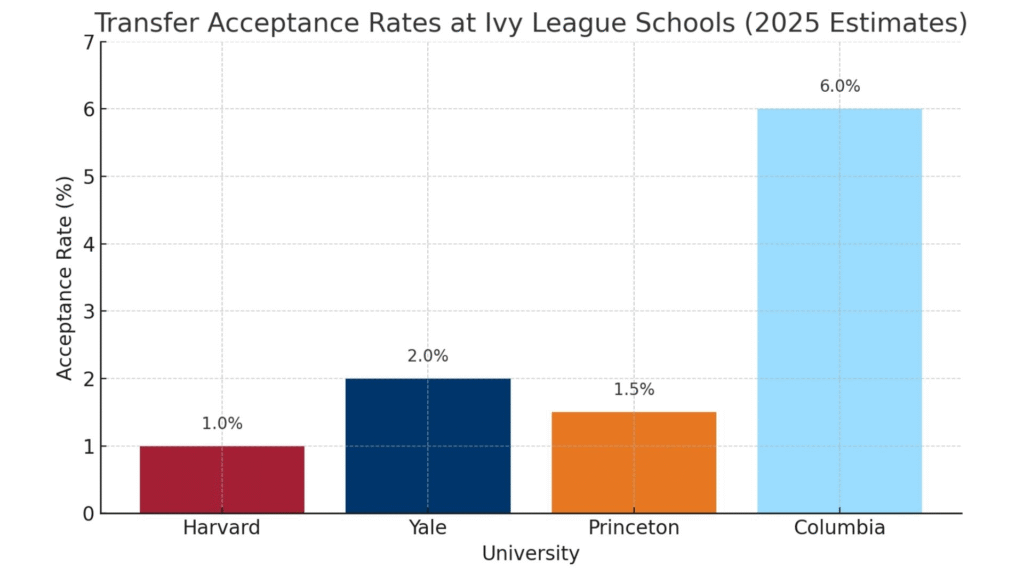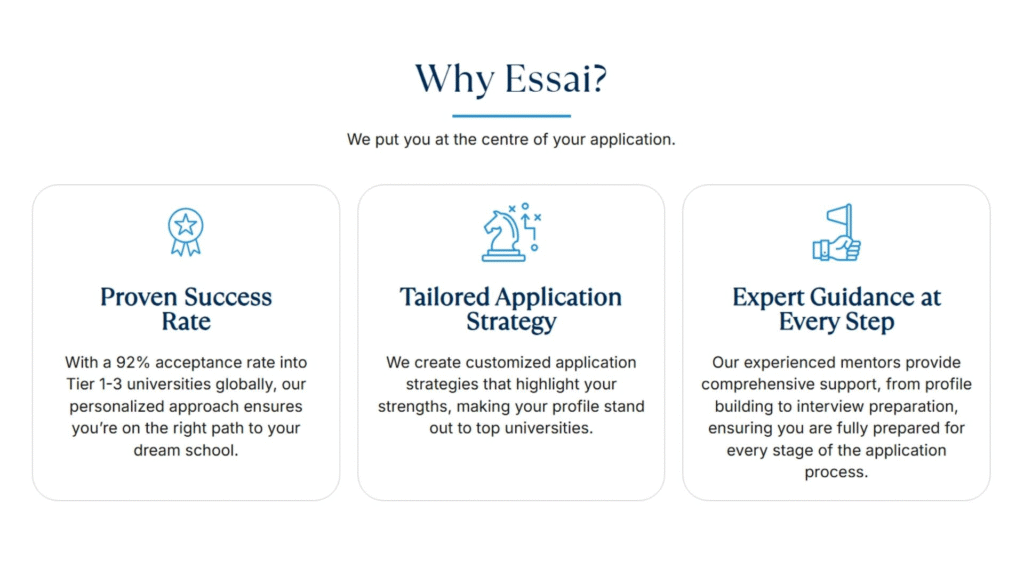Are you halfway through college and wondering if the Transfer Student Strategies 2025 could be your path to an Ivy League education?
Feeling like your current university isn’t quite the perfect fit?
Are you halfway through college and still dreaming of an Ivy League education? Feeling like your current university isn’t quite the perfect fit?
Wondering if it’s too late to pivot your academic journey? You’re not alone. And more importantly, you’re not out of time.
With the right Transfer Student Strategies 2025, you can craft a compelling application that grabs the attention of top U.S. universities.
This blog is your detailed roadmap to transferring mid-degree, including how to build your narrative, strengthen your profile, and improve your odds of acceptance to elite institutions.
Understanding College Transfers

The process of transferring to a new university can seem overwhelming, but understanding the key aspects can help make your transition smoother.
If you’re planning to transfer to a Top US College, it’s essential to know how academic credits, admission requirements, and application deadlines work.
Each institution has specific policies, so researching your target schools in advance will improve your chances of success.
When students transfer to a Top US College, they often seek better academic programs, networking opportunities, and career advancement.
A well-prepared transfer application includes a strong GPA, compelling essays, and letters of recommendation.
Additionally, understanding how financial aid and scholarships apply to transfer students can impact your decision.
If you’re determined to transfer to a Top US College, start by evaluating your academic goals, researching colleges that accept transfers, and preparing a standout application.
With the right strategy and guidance, securing admission to a prestigious institution can be within reach!
Why Do Students Transfer to Top Colleges?

1. Academic Reasons
- Lack of Academic Challenge: Students often transfer when their school lacks academic challenge or relevant courses.
- Mismatch in Academic Programs: Students may transfer to pursue programs or majors that their current school doesn’t offer.
- Better Opportunities: Students may transfer to a school that offers more research opportunities, internships, or academic support that helps them achieve their career or educational goals.
2. Personal and Social Reasons
- Social Disconnection: Students may feel socially isolated or struggle to connect with peers at their current school. A new school may offer a different environment with more opportunities to meet people who share their interests and values.
- Bullying or Negative Environment: If a student experiences bullying, harassment, or feels unsafe, they may transfer to a school where they feel more supported and secure.
- Desire for a Fresh Start: Personal challenges, such as struggling with their current school’s social or emotional environment, may motivate students to transfer to a new school where they can leave behind negative experiences and start over.
3. Career and Future Goals
- Pursuit of Career Goals: Some students transfer to schools with stronger ties to industries they are interested in. For example, transferring to a school with better internship opportunities or a strong alumni network can help students gain connections and experiences relevant to their desired career path.
- Ivy League or Prestigious Institutions: Students aiming for top-tier colleges or Ivy League schools may transfer from less competitive institutions to increase their chances of securing internships, job offers, or graduate school placements.
4. Practical Considerations
- Location or Family Reasons: Some students transfer schools due to family relocation or if their current school is too far from home, allowing them to be closer to family or a particular geographic location.
- Financial Reasons: Financial constraints may lead a student to transfer to a more affordable school that offers better scholarships, financial aid, or lower tuition costs.
- Campus Environment: If the learning environment is not suitable (e.g., overcrowded classes, a lack of resources, or an uninspiring campus culture), students may transfer to a school that offers a more conducive academic atmosphere.
5. Health and Well-being
- Mental or Physical Health: Students may transfer for better mental health support and a more supportive environment.
- Disability Support: Students who need specific accommodations due to a disability may transfer to a more equipped school to handle their needs.
6. Desire for a New Experience
- Exploring Different Cultures: Some students transfer to experience a new academic or cultural environment.
- Campus Activities and Extracurriculars: Students often transfer to access better extracurriculars, sports, or clubs.
Chart Analysis: Understanding the Transfer Landscape in 2025

The bar chart above illustrates the estimated transfer acceptance rates for top Ivy League schools in 2025, and it highlights just how competitive the landscape truly is:
- Harvard University shows a transfer acceptance rate of approximately 1%. This reflects the institution’s minimal intake for mid-degree applicants and the high standards expected from potential transferees.
- Yale University appears slightly more flexible, with a rate of around 2%. However, this still underscores intense competition, requiring a near-flawless academic and extracurricular record.
- Princeton University also reports an estimated 1.5% acceptance rate, showing that while they do consider transfer students, the bar for entry remains very high.
- Columbia University stands out with a comparatively higher acceptance rate of 6%. Among the Ivies, Columbia is known for having a slightly more transfer-friendly policy, offering more slots and flexibility.
What does this mean for you?
This chart is a crucial part of your Transfer Student Strategies 2025 planning. The low acceptance percentages reinforce the need to:
- Build a standout academic record
- Craft a compelling transfer narrative
- Provide strong recommendation letters
- Show a clear alignment with the target university’s values and offerings
Understanding these statistics isn’t meant to discourage you, but to help you approach the process with realistic expectations and a strategy that increases your odds of success.
Partnering with experts like Essai can help you navigate these competitive waters with confidence and clarity.
Key Benefits of Transferring to a Top Global College
A well-planned Transfer Student Strategies 2025 opens doors to world-class education, whether your target institution is in the U.S., the U.K., Canada, Europe, Singapore, or elsewhere.
Transferring mid-degree can help you align your academic environment with your long-term goals, both personal and professional.
Here are the key benefits of transferring to a top global university:
1. Academic Advancement: Top universities offer more rigorous coursework, renowned faculty, and better learning infrastructure. You gain access to advanced subjects, research opportunities, and interdisciplinary programs that can sharpen your intellectual edge.
2. Enhanced Career Prospects: Transferring to a globally recognized institution strengthens your résumé. You benefit from stronger employer networks, on-campus recruitment by leading companies, and international internship programs that increase job readiness.
3. International Exposure: Studying in a new academic and cultural environment expands your global perspective. You’ll connect with students and professors from around the world, boosting your communication skills and cultural intelligence.
4. Access to Specialized Programs: Many global colleges offer niche courses or majors that may not exist at your current institution. Whether it’s sustainability, biotechnology, data analytics, or global health, transferring opens new academic paths.
5. Stronger Support Systems: Top institutions often provide better access to academic advisors, career counselors, mental health resources, and mentoring programs. These tools can help you stay focused and succeed during your transition.
6. Competitive Graduate School Edge: Graduate programs value applicants from prestigious institutions. Transferring can improve your chances of admission by exposing you to research, high-level coursework, and stronger letters of recommendation.
7. Financial Opportunities: Many leading colleges offer financial aid or scholarships specifically for transfer students. You may also find better value in terms of quality education per dollar, especially in countries with subsidized tuition.
8. Personal Growth: Moving to a new campus or country challenges you to adapt, build resilience, and grow independently. It’s a chance to redefine your goals and stretch beyond your comfort zone.
Let’s explore Transfer Student Strategies 2025: How to Make Your Application Attractive Mid-Degree.
Transfer Student Strategies 2025: How to Make Your Application Attractive Mid‑Degree

Step 1: Research Transfer Policies Thoroughly
Every school has different deadlines, requirements, and expectations for transfer applicants.
Use platforms like:
- Common App for Transfer Students
- College Board’s BigFuture
- University websites (e.g., Harvard, Cornell, Columbia)
Make sure you:
- Check minimum GPA requirements
- Know how many credits are transferable
- Review application components (essays, LORs, SAT/ACT, etc.)
- Understand deadlines, often March 1 or earlier for Fall entry
As part of your Transfer Student Strategies 2025, start a research tracker using tools like Trello or Airtable to organize each college’s requirements and timelines.
Step 2: Assess and Improve Your Current Academic Record

Your college transcript matters more than your high school grades. Most top colleges want to see:
- Consistent academic rigor
- Strong GPA (3.5+ preferred)
- Relevant coursework for your intended major
- Progression and improvement if you had a slow start
Use tools like a Google Sheets GPA Tracker or Excel GPA calculator to monitor and simulate your GPA growth before you apply.
A strong upward trend can demonstrate resilience and focus, both valued in a Transfer Student Strategies 2025.
Step 3: Craft a Clear Transfer Narrative

Your personal statement or “Why Transfer?” Essay is crucial. Here’s how to build your story using the STAR method:
- Situation: What led you to your current college?
- Task: What did you hope to gain?
- Action: What changed or didn’t work?
- Result: Why is transferring now the right step?
Sample prompt from Common App:
“Please provide a statement that addresses your reasons for transferring and the objectives you hope to achieve.”
Your Transfer Student Strategies 2025 should convey clarity, maturity, and academic focus. Avoid sounding negative about your current college; focus on growth and opportunity.
Pro Tip: Work with a mentor at Essai to review your essays for impact and tone.
Step 4: Choose Professors for Recommendations Strategically
Unlike first-year applications, transfer applications often require college professors to write your Letters of Recommendation. Choose faculty who:
- Taught you in a rigorous or relevant subject
- Can speak to your academic engagement and growth
- Know you personally through class discussions or office hours
Essai helps students prepare LOR request packets, including your resume, statement of purpose, and key talking points,so your recommender can write a tailored and powerful letter.
Step 5: Leverage Extracurriculars and Leadership Roles
Transfer Student Strategies 2025 is not just about grades.
Colleges want to see how you’re making an impact beyond the classroom. This includes:
- Club leadership (even at your current school)
- Community service or local volunteering
- Internships or research experience
- Side projects (especially academic or creative work)
- Virtual volunteering (check out VolunteerMatch)
Highlight your growth mindset and adaptability,especially during transitions.
Want to track and organize your extracurriculars?
Try PIPPAMS, Essai’s profile-building platform that helps students document impact and track activities year-over-year.
Step 6: Prepare for the Credit Transfer Maze
One of the most confusing aspects of transferring is credit compatibility. Here’s what to do:
- Match your course descriptions with target school syllabi
- Save syllabi, assignments, and grade reports
- Meet with your current academic advisor
- Review each school’s credit transfer policy
Use this information in your Transfer Student Strategies 2025 planning matrix. Colleges like clarity, and when you show initiative, it improves your chances.
Step 7: Align Career Goals with the New Institution
This is often overlooked but crucial.
Top schools want to know:
“How will our college help you achieve your academic and professional goals?”
Make your answers specific:
- Mention the faculty members you want to work with
- Reference labs, departments, or research centers
- Point out alumni networks in your field
- Show how the curriculum structure supports your goals
Essai’s counselors can help map your long-term goals to school offerings, so your application feels coherent and intentional.
Step 8: Use Tools That Simplify the Transfer Process
Here are platforms to integrate into your Transfer Student Strategies 2025:
| Tool | Purpose |
| Common App | Application portal for 600+ colleges |
| Cialfo / MaiaLearning | College research and counselor communication |
| Google Drive | Document portfolio & backup |
| Grammarly | Essay polishing |
| PIPPAMS | Track activities, goals, and mentor feedback |
Bookmark and organize all of these tools for seamless application prep.
Step 9: Stay Ahead with a Transfer Timeline
Here’s a sample timeline for a Fall 2026 transfer:
| Month | Task |
| Sep–Oct 2025 | Shortlist target colleges |
| Nov–Dec 2025 | Draft personal statement and essays |
| Jan 2026 | Request transcripts and LORs |
| Feb 2026 | Finalize and submit applications |
| Mar–May 2026 | Attend interviews or submit additional materials |
| May–Jun 2026 | Accept offers and prepare for transition |
Using a timeline is key to any successful Transfer Student Strategies 2025. Essai provides personalized transfer timelines tailored to your target schools and application gaps.
Step 10: Work with Mentors Who Know the Game

Crafting a transfer application, especially to elite schools like Yale or UPenn, requires strategy, structure, and effective storytelling.
That’s where Essai comes in.
Our team of Ivy League alumni and seasoned admissions counselors offers:
- Profile evaluations
- Essay editing
- Strategic guidance
- Customized timelines
- Activity tracking via PIPPAMS
Working with Essai helps eliminate guesswork and gives your Transfer Student Strategies 2025 the polish it deserves.
Key Mistakes to Avoid in Your Transfer Application
- Generic essays
- Weak academic performance in college
- Poor recommendation choices
- Inconsistent extracurricular involvement
- Failure to explain the “why” behind your transfer
Essai’s expert review process ensures your Transfer Student Strategies 2025 avoids these common pitfalls.
Why Choose Essai for Your Transfer Journey?

Essai offers a comprehensive support system designed specifically for transfer applicants seeking admission to top global universities.
Through personalized mentorship, students receive one-on-one guidance from experts who understand the complexities of mid-degree transitions.
What sets Essai apart is its team of Ivy League alumni advisors who bring insider knowledge and strategic insight to every step of the process.
From creating a realistic application timeline to ensuring consistent progress and accountability, Essai helps you stay on track with confidence.
You’ll also receive expert support for writing impactful personal essays and securing strong letters of recommendation.
Additionally, students gain access to PIPPAMS, a powerful tool for profile-building that tracks achievements, activities, and long-term goals.
Unlike other services that focus only on forms and deadlines, Essai goes beyond the paperwork to help you craft a transfer application that tells a compelling, authentic story.
Final Thoughts: Is Transferring Worth It?
Absolutely if you’re intentional, prepared, and strategic.
You’re not starting over. You’re leveling up.
Transferring is not a weakness; it’s a reflection of your commitment to growth, academic ambition, and self-awareness.
As you build your Transfer Student Strategies 2025, remember this: you’re not the only one taking the leap but you can be the one who lands it best.
FAQs
Q. Is transferring to an Ivy League school possible mid-degree?
A: Yes, but it’s highly competitive. Only a few seats are offered to transfer students, so a strong narrative, high GPA, and impactful extracurriculars are essential.
Q2. Do I need to submit SAT/ACT scores again as a transfer applicant?
A: Depends on the college. Some waive it for transfers, others require it. Always check each school’s policy via Common App or the university website.


